EBR charges a service fee to manufacturers to produce ebike reviews and videos, this began in 2018. It’s the same flat fee for each bike, and it helps us to keep the site going while limiting ad clutter. We appreciate the opportunity to serve you with our opinions and data but respect your right to know that we receive compensation :)
The City Commuter is one of Pedego’s more active urban ebike models. It’s a bit more upright and efficient than their cruisers, with narrower handlebars that can fit between cars and through doorways. Compared to a lot of other commuter bikes, it leans more towards the cruiser aesthetic and prioritizes comfort with larger tires, an adjustable stem, longer bars, a padded saddle, and wider metal fenders. This bike weighs a bit more, but offers a lot of power and zip. Most of the drive system weight is positioned at the rear of the bike (the hub motor and battery box), but that frees up the center of the frame for bottle accessories and an easier step-thru frame design. You can get this bike in two frame styles and three sizes… as well as a 28″ wheel or 26″ wheel (step-thru only) which lowers the frame for easier mounting and stand-over stability. Way back in 2013, Pedego had just introduced their first generation of City Commuter, and I purchased one at Rocket Electrics in Austin to commute to work downtown. It held up well, offered pedal assist and throttle mode (useful for quick starts and a bit of help when climbing), and made my commute a whole lot cooler and more enjoyable on the hot summer days. With the Black Edition here, there are lot of little upgrades and refinements compared to that older City Commuter and the current generation standard City Commuter. It offers a lightweight, highly adjustable, air suspension fork. You get large hydraulic disc brakes that are easier to pull than mechanical. And, the color scheme is completely black. This helps to hide wires (most of which are already internally routed to stay clear while you pedal) and allows the motor and battery box to blend in. Pedego offers a premium version of their other popular model, the Interceptor, which is called the Platinum Interceptor and comes with similar upgrades. As an average-sized rider, and fan of the City Commuter platform, this Black Edition is right up my alley and I love that they didn’t forget about safety. Riding an all-black frame in the dark, especially commuting in a city, could mean that you’re less visible. So, Pedego upgraded the tires to have reflective stripes and includes two integrated LED Lights to keep you safe here.
Driving this bike is a Dapu branded planetary geared hub motor, spoked into the rear wheel. Offering 500 watts nominal and surging all the way up to 1,058 watts, it really feels strong. You get up to 45 Newton meters of torque, which is actually quite high for a hub motor… and it feels stronger than a lot of competing models which claim 60+ Nm, it’s a stat that I suspect many brands embellish. With Pedego, you’re getting a tried and true product that is made to capture a “fun” experience and be capable of moving larger riders. Both founders are sturdily built fellows and live in hilly areas. They have produced something here which “just works” in my experience, and really expanded the drive modes with recent updates to provide fluid torque sensing assist, zippy cadence sensing assist, or the twist throttle mode. The default top speed is 20 mph, but you can easily lower it to 15 mph (25 km/h) to extend range or comply with local laws, as is the case in parts of Europe. The great thing about hub motors is that they don’t interfere with pedaling and shifting gears the way that mid-drives do. Many members of the Pedego staff still prefer these hub-driven bikes, even though the company is slowly expanding into mid-motors (there is a Dapu mid-motor powered City Commuter available now, and a fancy Shimano mid-motor powered mountain bike). Having test ridden many, many electric bikes over the years, the majority of which did use hub motors, I have to say that Dapu is my personal favorite. They seem reliable and are designed so that the power cable coming from the 21 amp controller is tucked neatly behind the left chain stay. It’s a lot less vulnerable and crowded compared with the cables that stick out from the right axle. If you opt for the 26″ wheel size on the smallest step-thru, you’ll get the best mechanical advantage and wheel strength, but all of the bikes are spoked with sturdy 12 gauge wires to increase durability… and the spokes are black ;)
Powering this, and many of the other City and Cruiser models from Pedego, is a rack mounted Lithium-ion battery pack that’s available in two sizes. The stock battery offers 48 volts with 10 amp hours, and the upgrade offers 15 amp hours. The difference is 480 watt hours vs. 720 watt hours, which will let you ride further. I was told that most customers do upgrade the battery, and this costs $300 at time of purchase. The battery is one of the most expensive parts of the bike, and Pedego has done a lot to ensure that it lasts for you. First, the pack actually slides into a plastic housing which is permanently mounted in the rack. This housing protects the plastic casing on the battery itself and recesses the electrical connectors way up at the end. There’s a locking cylinder on the left side of the mount that secures the battery from tampering and theft, and you do not need to leave the keys inserted when riding (as you did with some of the older products). The cells that Pedego is using for many of the e-bike batteries are from Panasonic, and are regarded as being very high quality and reliable. However, Pedego has also included a physical fuse and on/off toggle switch (protected by a water-resistant housing) near the base of the pack. Paul Oclaire, the lead product designer at Pedego since 2012, told me that they recently introduced a sleep mode into the battery software too. So, depending on how full it is and how long it has been since you last took a ride, the pack will avoid completely draining out, which can be hard on the cell chemistry. I think it’s great that you can charge these packs while mounted to the bike or separately, and that the included battery charger is a bit faster, offering three amps vs. the standard two. All in all, it’s a great design, but the position of the pack is definitely a compromise. Ideally, you’d want all of the heavy components on the bicycle to be as low and centered as possible. This improves stability and handling… However, this also limits the design options of the frame (specifically around step-thrus). So, Pedego went the other direction here and stuck the pack in a rack that can be used for hauling food, books, or other cargo up to ~55 lbs. Since both the battery and hub motor are rear-mounted, the bike is definitely rear heavy, but it still rides pretty well and feels stable because of the wider tires.
Another upgrade to the latest round of battery packs is the addition of a Bluetooth chip which connects to a smartphone application. I was not able to see the app during my visit and review ride, but am told it will offer turn-by-turn navigation, social integration (so you can share rides with friends), and help with after-sales diagnostics and service. Pretty sweet! There are a lot of new apps for electric bikes, but I really appreciate the inclusion of a default LCD display panel as well. The one chose for the City Commuter Black Edition offers all of the standard readouts (power output meter, current speed, battery capacity, and assist level) but also gives you some little extras. Tap the power button to turn the bike on (once the battery is also switched on), the press the + or – keys to raise or lower assist. The lowest setting is 0 which provides no assistance or throttle activation and is simply a way to run the lights while pedaling manually, and see your speed and other trip stats. As you press the plus key, you go through 1-4 that offers torque sensing assistance, 5 for cadence sensing assistance, and 6 for throttle only operation. The twist throttle offers variable power and speed output, depending on how far you twist. It can override the other five levels of assist, or you can turn it off and unplug it if you want. To get into the settings menu and adjust top speed, just hold the Set key for a few seconds. Each menu here has a number and 6 is where you can choose off to limit the bike at 15 mph. Menu section 7 allows you to de-activate the torque sensor and ride 1-4 in cadence sensing mode only. It’s neat to have options like this because some people may prefer the cadence mode (I do, because my knee is sensitive and I don’t enjoy pushing hard). To activate the integrated lights, and turn on the LCD backlighting, just tap the power button again once the display is on. To activate the USB port underneath the display, just hold + and Set for a few seconds. Paul told me that they disabled the port by default as another measure of protection for the battery pack. In short, I found the display to be easy to read, relatively easy to reach from the left grip, and useful with the USB port. It is not however, removable or easy to swivel (to reduce glare). This means that it could take some weather damage over time (sun fading, water spots), and get scratched by neighboring handlebars and brake levers. My own City Commuter display did fairly well all those years ago, but did get some condensation inside after a bunch of big rain storms in Austin… It was a completely different design and Pedego has chosen all of their electronic parts to be highly water resistant.
Pedego electric bikes are priced at a premium because they use quality hardware and sell through brick and mortar dealers who assemble, offer test rides and rentals, and support the bikes ongoing. They offer a solid two-year comprehensive warranty on all of the parts and lifetime coverage of the frame. It’s really neat to see how they have preserved the classic aesthetics of city and cruiser bicycles, and even kept the original City Commuter ebike design in tact while slowly and carefully upgrading the hardware and software components to provide more options. This bike brings a lot of comfort, but you can also lock out the suspension fork and angle the bars down for a sportier feel. The suspension seat post is adjustable for riders of different weights, and the tire pressure range is pretty wide, so lightweight riders such as myself can lower a bit to reduce vibration and jar. I love that the tires are pre-Slimed to help deal with any little punctures, and the tires themselves have a puncture resistant layer built-in. Not everything is perfect here, the kickstand is mid-frame mounted which puts it in the way of the left crank arm if you back the bike up. There are provisions for adding a rear-mount kickstand towards the back if you want. There’s a bottle cage mount on both frame styles, but the rear rack uses such thick tubing that it may not accommodate all clip-on panniers. The rear light is a little weak, but the headlight is bright and aimable. Both are powered by the main battery pack for convenience, but the headlight is mounted on the moving part of the suspension fork and may bounce vs. if it was mounted just above on the headset, stem, or handlebar. The bottom bracket is square tapered vs. splined and I am not sure if the bearings are sealed cartridge, so I welcome feedback about how they hold up to water over time (squeaking and creaking?) The newer cadence/torque sensors, mounted at the bottom bracket, are completely sealed and very durable compared to the old external ones. And, the fenders and chain cover are steel, which could rust if scratched… they are sturdy and relatively quiet, and I do appreciate the flexible rubberized end pieces to limit damage from contact with feet and curbs. The tool-free adjustable stems can also be a fail point for heavy use and larger stronger riders, so keep an eye on it and keep it tight. Paul did say that the stem comes with Loctite to keep it tight by default. I love how the saddle can go all the way down, to reduce body position height, without colliding with the rear rack and any cargo that might be attached. The step-thru frame may flex a bit if you stand and pedal or turn hard, but that’s not uncommon for bikes like this (especially with rack batteries). Big thanks to Paul and the Pedego team for partnering with me on this post. It’s always neat to visit the company headquarters and was a big treat to see all three versions side by side. I welcome your feedback in the comments below and invite you to connect in the Pedego forums to share your experiences, pictures, and any questions.
Pros:
- Pedego makes this bike in two styles (high-step and step-thru), offers three frame sizes, and even has a 26″ wheel version (the default is 28″) which brings the bike closer to the ground for petite riders, it all adds up to a great fit and increased control
- Bottle cage bosses! It may not seem like a big deal, but I love how Pedego has started including bottle cage bosses on the frame tubing so you can bring a folding lock, water bottle, mini-pump or other accessory without needing a trunk bag or panniers
- The Black Edition just looks awesome, everything matches and ties together, cables and wires blend in perfectly with the black frame and even the stanchions on suspension fork have been anodized black vs. stock silver on cheaper steel forks vs. aluminum here!
- Comfort is a big deal to me, especially with electric bicycles because I tend to ride a bit faster and further on average, so the nice air fork, suspension seat post, comfy saddle, swept back handlebar, adjustable angle stem, and puffy grips make this thing feel amazing
- Safety is a big deal, especially on a matte black electric bike… so it’s cool that Pedego opted for the nicer puncture-resistant tires with reflective sidewall stripes and integrated a bright headlight and backlight, consider adding some black reflective stickers and a bright rechargeable light for your helmet and backpack to go even further
- Pedego is one of the few e-bike brands, that I’m aware of, which offers pre-Slimed tubes on many of their products, this adds another level of convenience and durability, you can tell they are Slimed by the green caps
- This electric bicycle offers almost every type of drive mode you could ask for… no assist or throttle (just the display and lights active), cadence and torque sensing assist with throttle override, and throttle only! it allows you to ride in a way that feels comfortable and matches your style vs. being forced into something
- Assist is great, but stopping is also extremely important, especially if you weight more or are carrying gear, so the large 180 mm hydraulic disc brakes (with adjustable levers) are a perfect fit, they provide great mechanical advantage and require less hand effort to activate, I love that both brake levers also have motor inhibitor switches built in, so you don’t get out of control
- Dapu makes reliable and powerful hub motors (and mid-drives now) and I noticed that their power cable design is more protected and hidden than some Bafang and Das-Kit designs, I like how the axle has mini torque arms to spread the drive force out into the alloy frame and that the cable is run between the disc brake and left chain stay vs. protruding out of the axle where it could get caught or bent
- I love the trigger shifters on this model because they are easy to reach and are indexed to shift quickly, it’s got a really nice Shimano SLX derailleur (one step up from Deore and one step down from XT) that is lightweight and reliable, there’s even a one-way clutch that tightens the shifter spring and reduces chain bounce (the little grey lever, put it in the up position to tighten or down for servicing the rear wheel or easier shifts)
- Both wheels have been spoked with extra-thick 12 gauge wiring vs. the standard 14 (lower number means thicker), so the bike can support more weight and force from the motor, I like that they used black spokes because they match
- The battery can be charged on or off the bike, has a spring loaded locking cylinder and you DO NOT have to leave the key in for the bike to be turned on (which reduces jingling noises and potential snags), the pack has a fuse built in for safety and a water-sealed on/off switch so you can keep people from tampering with the display when you park at a public rack, the Lithium-ion cells inside are higher quality Panasonic brand
- The display panel seems tough, is easy to reach and read, and it even has a full sized USB Type A port built into the bottom for charging phones, music players, additional lights etc. just hold + and Set to activate the port (it’s disabled by default to reduce phantom power draw)
- I like the welcome kit that Pedego includes with all of their bikes, it looks nice and keeps things organized, you get a faster 3 amp charger which allows you to go riding more quickly and there’s even some touch up paint included
Cons:
- Many of Pedego’s cruiser and city bikes use the rear-rack battery design, which is easy to access and frees up the frame for approachable step-thru designs, but positions weight high and towards the back… which just isn’t as good for stability and frame stiffness
- The kickstand does a great job of stabilizing the bike, and I appreciate that it offers some adjustability (so you can keep the bike straight up or let it lean to the side a bit), but the position where it’s mounted creates pedal lock if you move the cranks or back the bike up without stowing the stand first, I prefer rear-mounted designs that stay clear of the cranks and this would probably also support the rear motor and battery better in this case too
- The rear light isn’t especially bright, but at least it stays out of the way if you add bags to the rack, the headlight is awesome but has been mounted to the suspension arch, so it will bounce up and down as you traverse rough terrain, having it mounted to the steering headset, stem, or handlebar would be better but might add clutter to those areas, it’s a trade off
- The fenders and chain cover feel sturdy and look great, but they were made from steel vs. aluminum and may be prone to rust if scratched over time, it’s great that Pedego includes touch up paint in their welcome box (with the charger, pedals, and manual) for if that does happen and Paul said that steel was stiffer and quieter so that’s part of why they chose it
- Most cruiser ebikes with fenders and racks weigh more, and this one is ~61 lbs (depending on frame size and type), I suggest removing the 8.9 lb battery pack before trying to lift or service the bike and have heard that the Thule EasyFold XT with loading ramp is a good choice for bikes with fenders
- This bike is a bit more expensive because Pedego only sells through dealers, offers great customer service, and has all of the frame sizes and battery size upgrade options
- The rear rack is really sturdy and looks nice, but uses thicker tubing that may not be compatible with the clip-on panniers a lot of third parties sell, consider one of Pedego’s own bag options
- Apparently, Pedego sells slap guards (so you can keep the right chain stay from getting silver chips from the chain slapping it) but you could also just use a piece of clear box tape, I’m a bit surprised that they didn’t just include a clear plastic guard like this by default, you can get black ones pretty cheap too
Resources:
- Official Site: https://pedegoelectricbikes.com/products
- More Pictures: https://photos.app.goo.gl/SfyDQ69sU5OmeS6y2

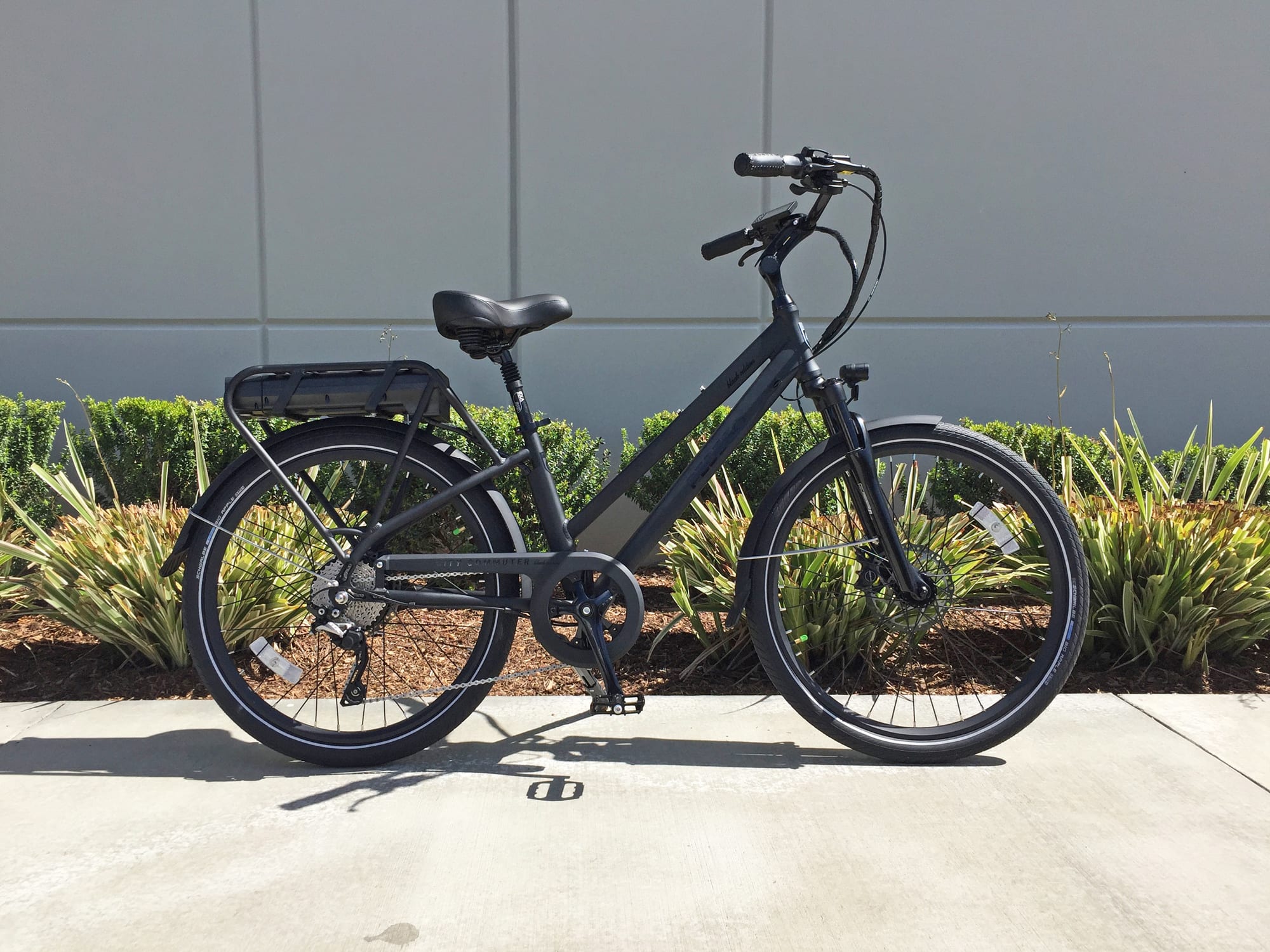
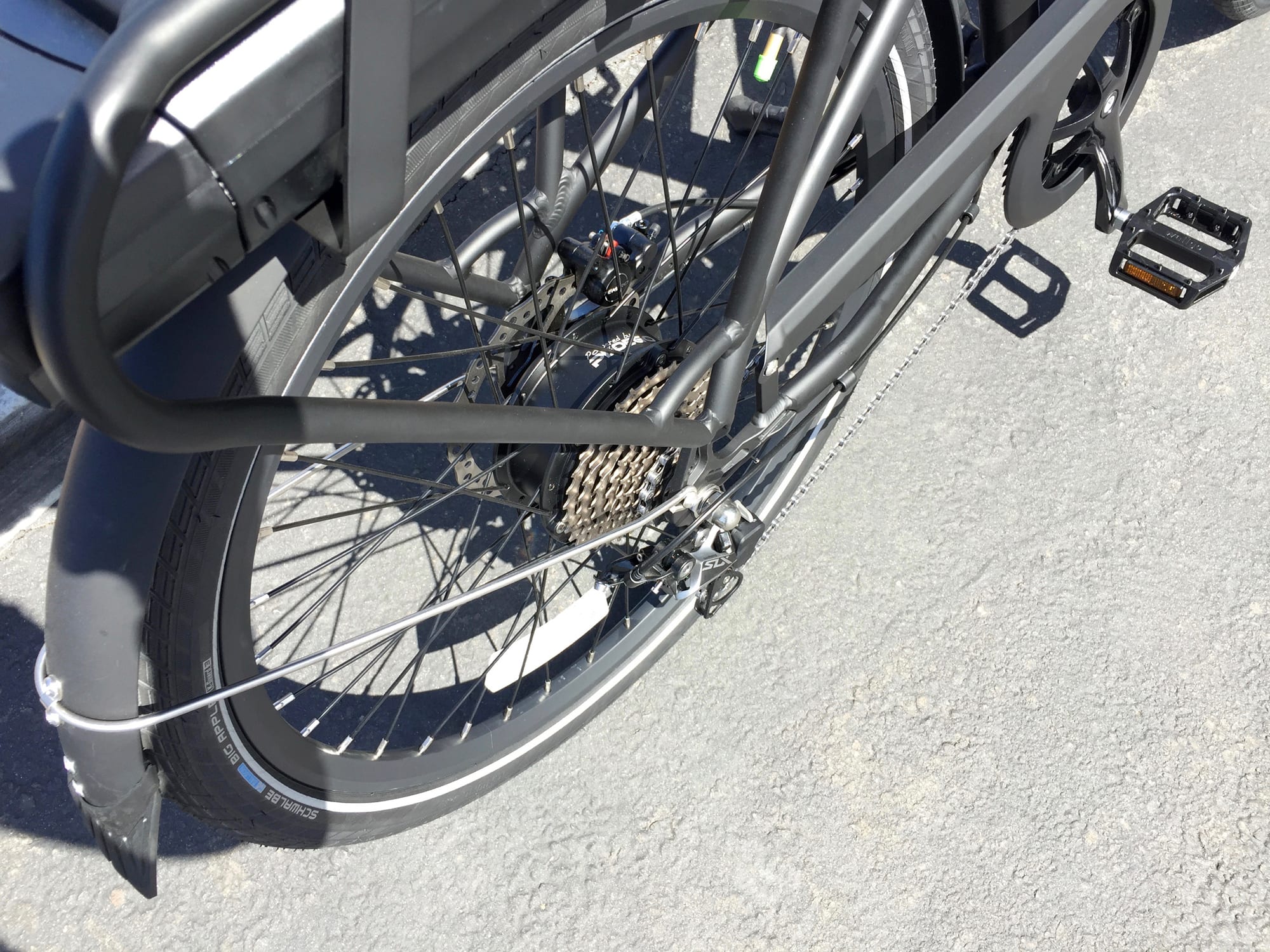
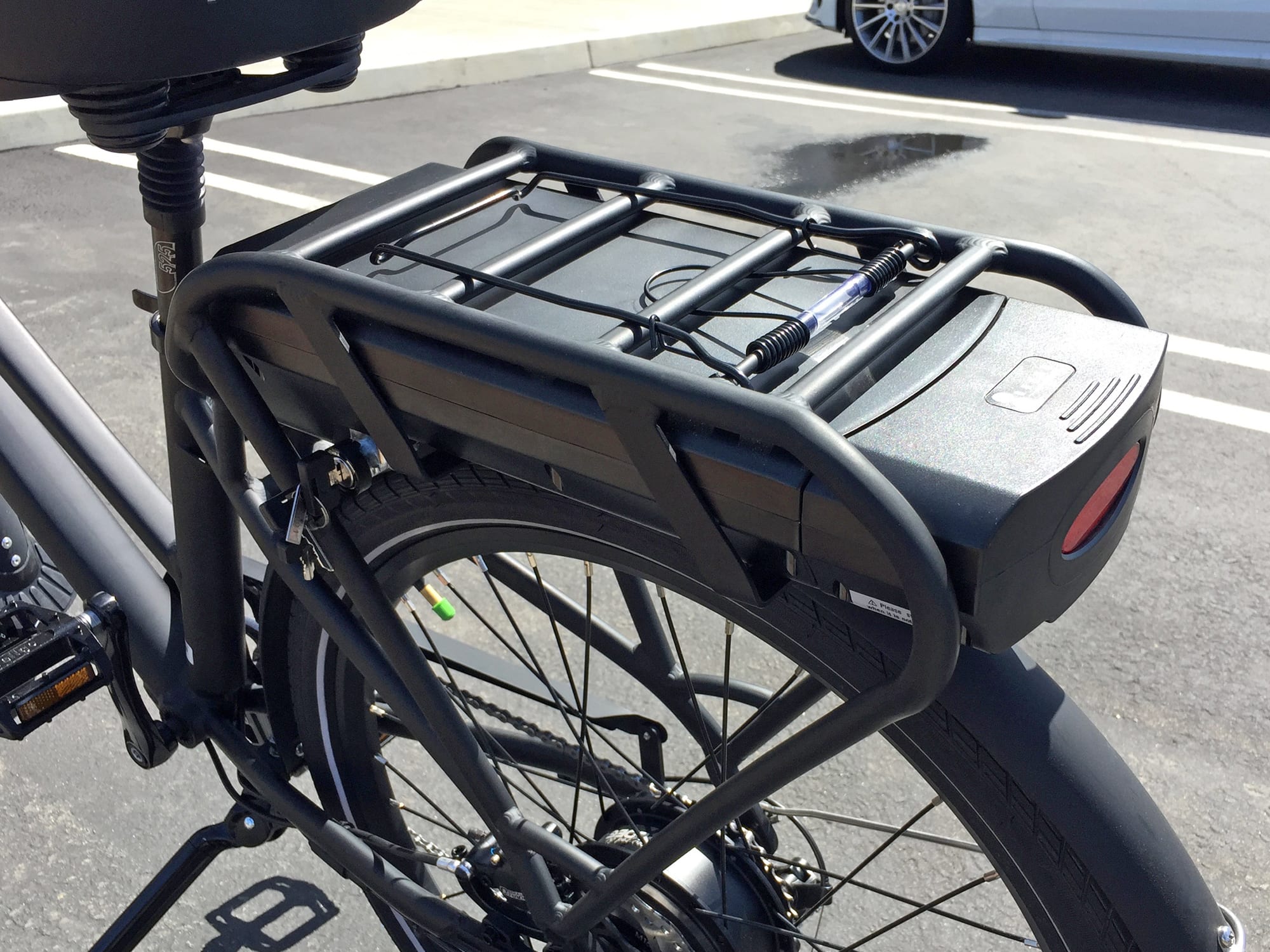
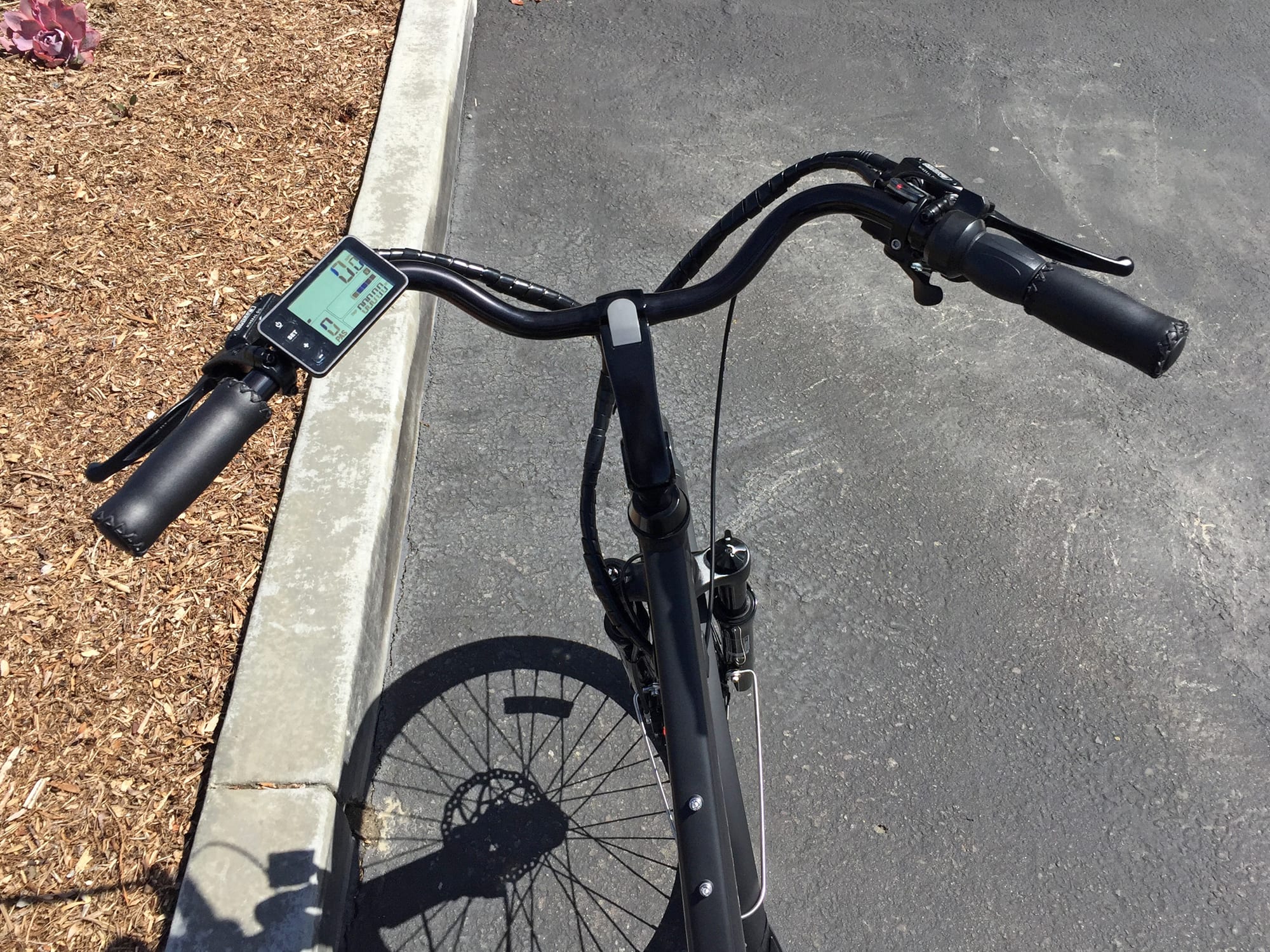
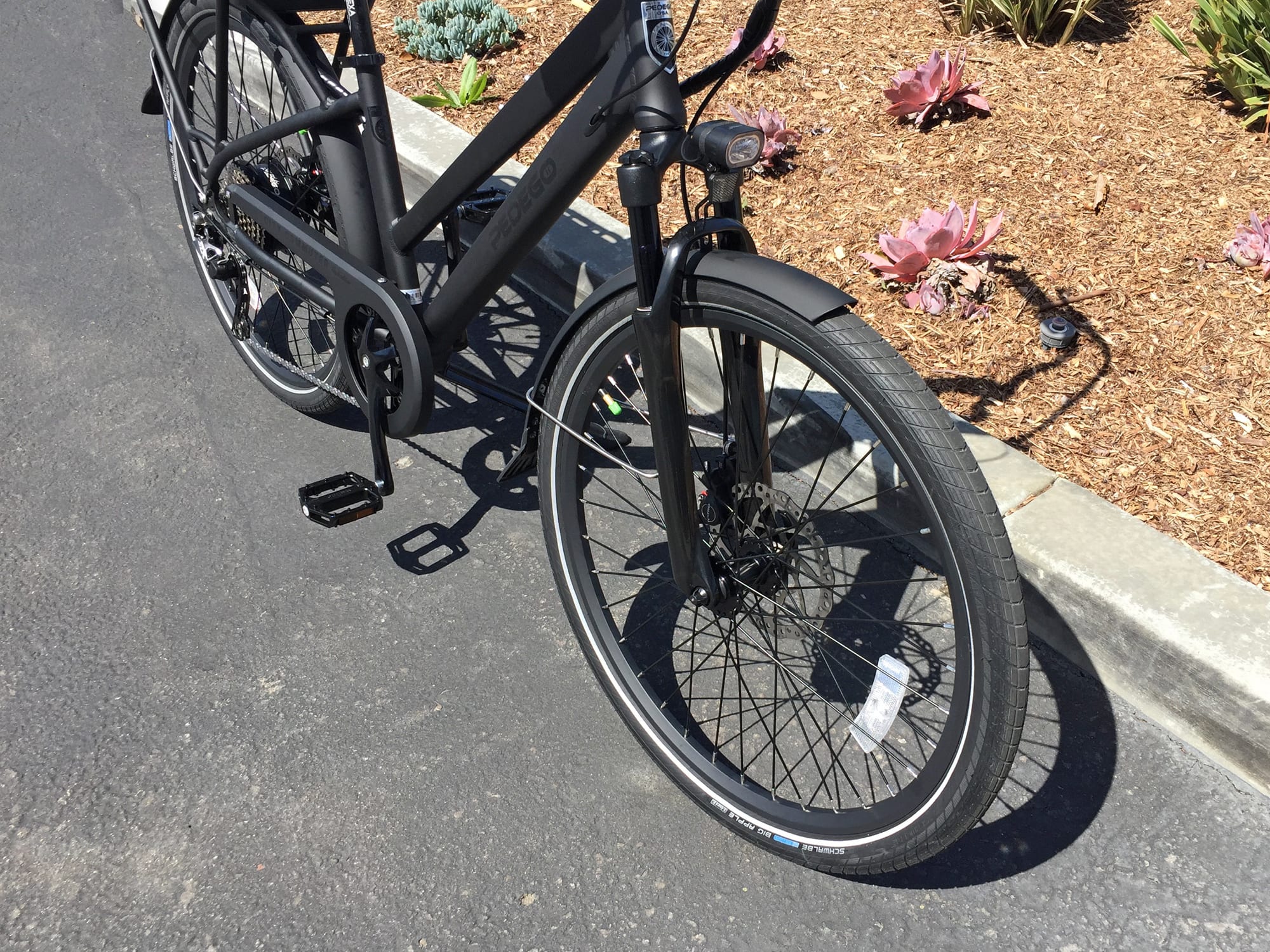
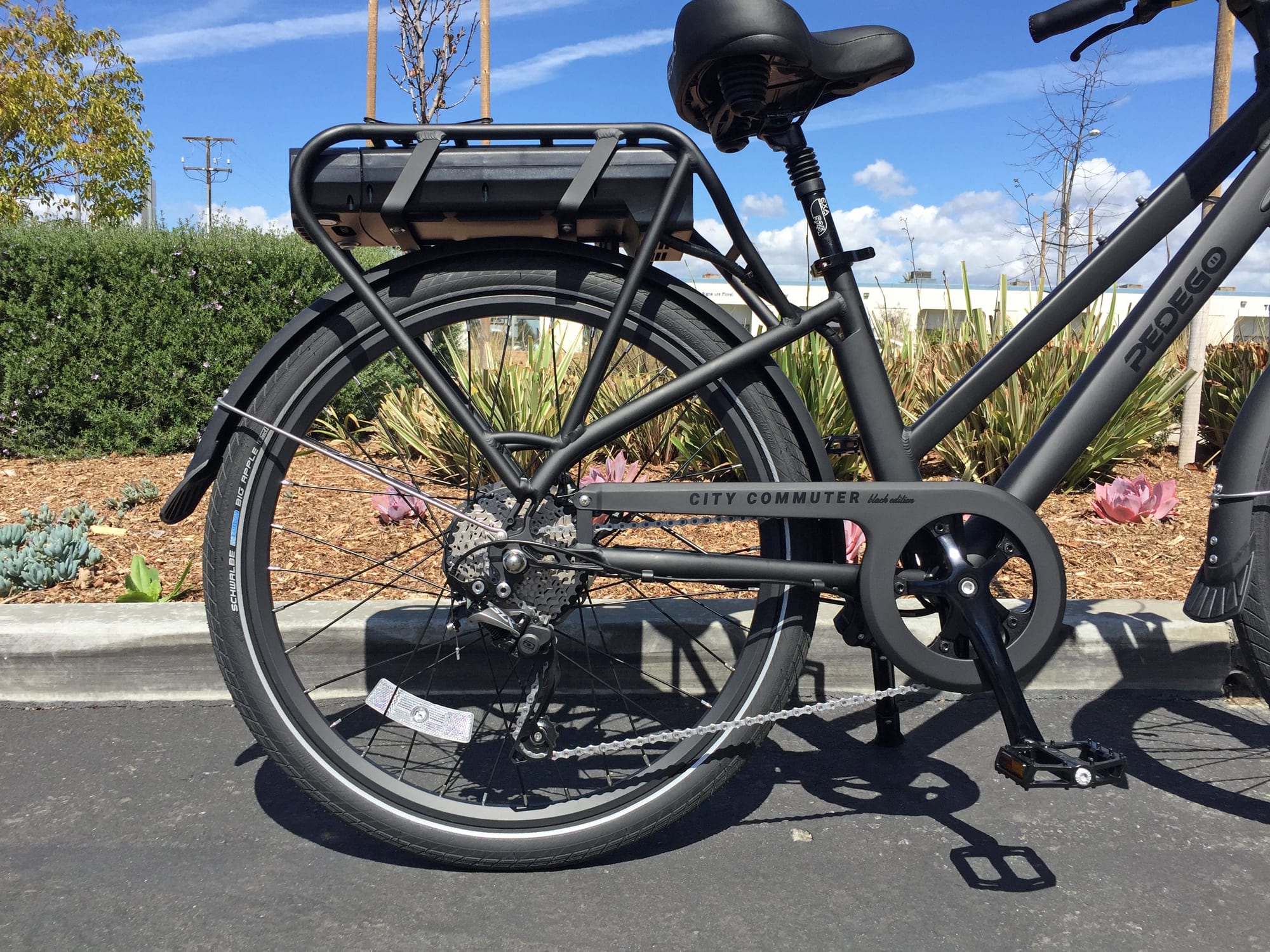
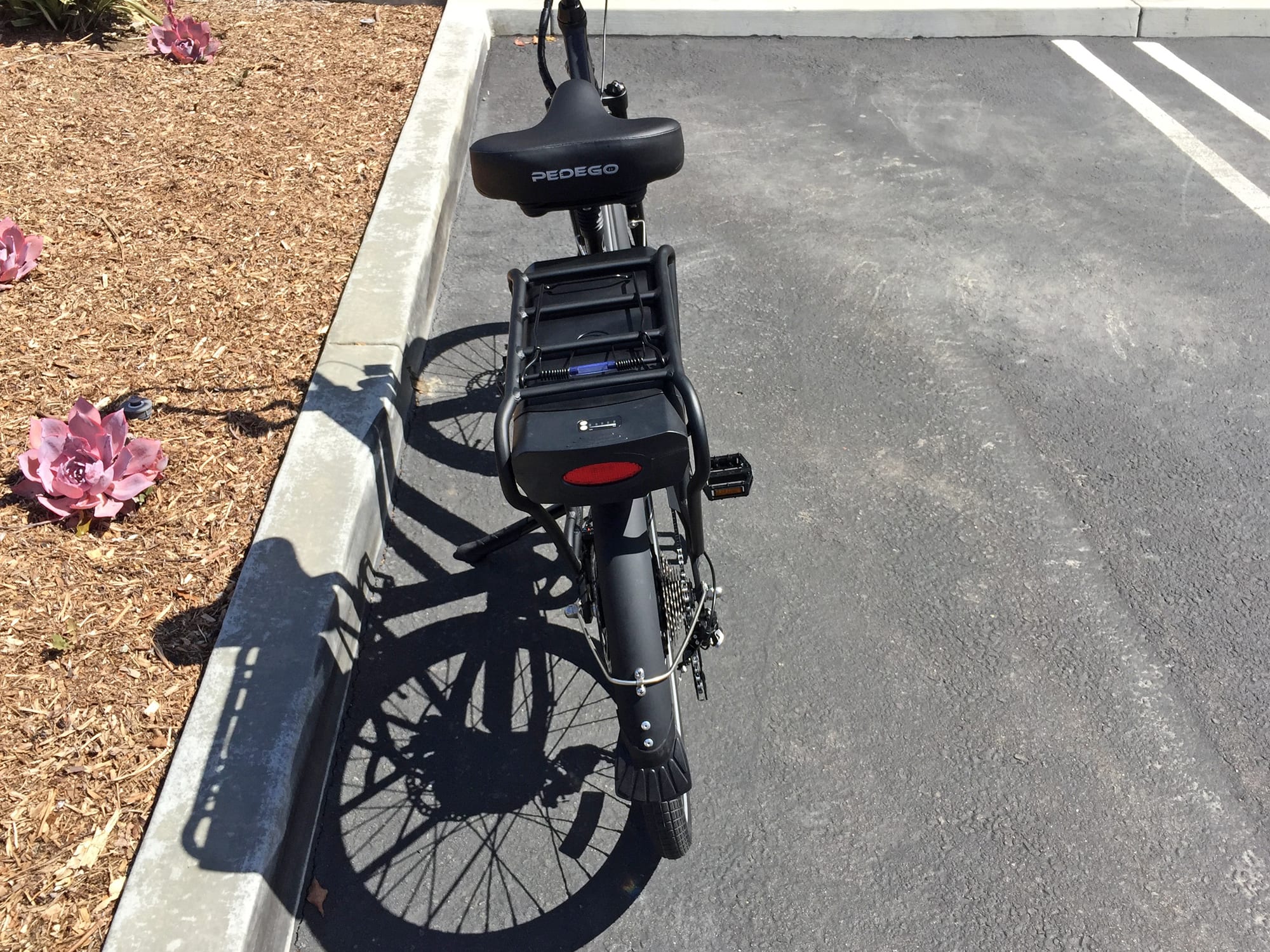
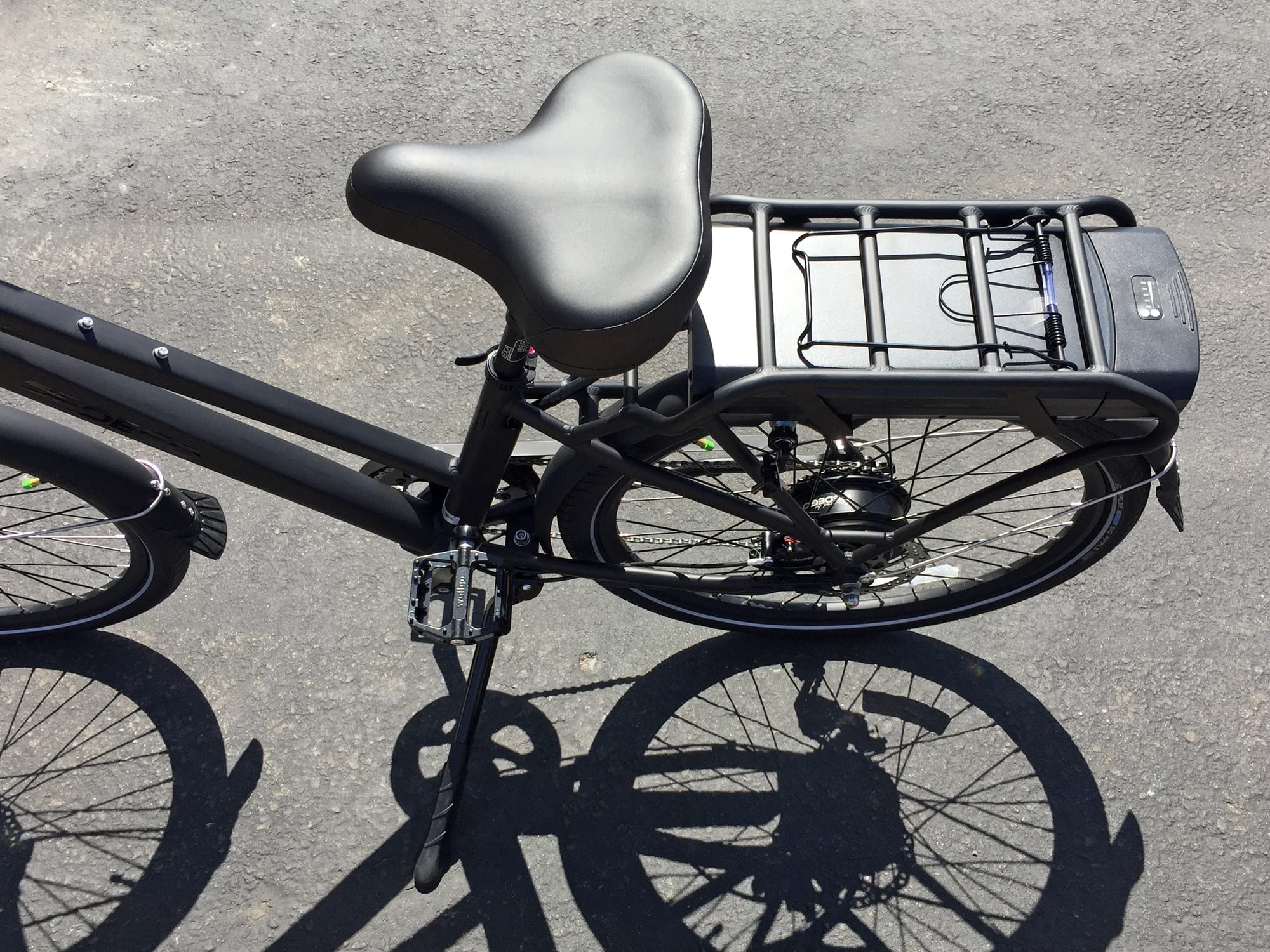


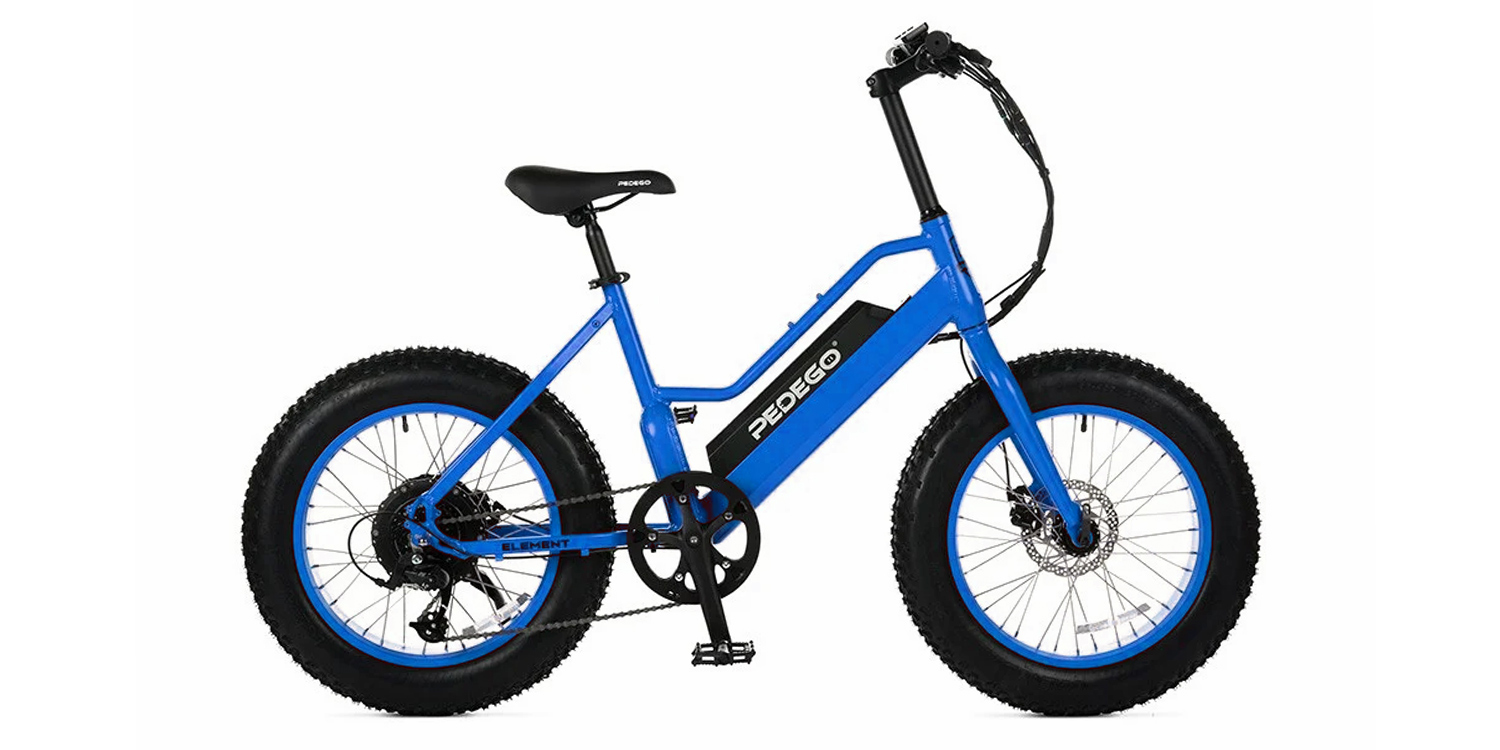
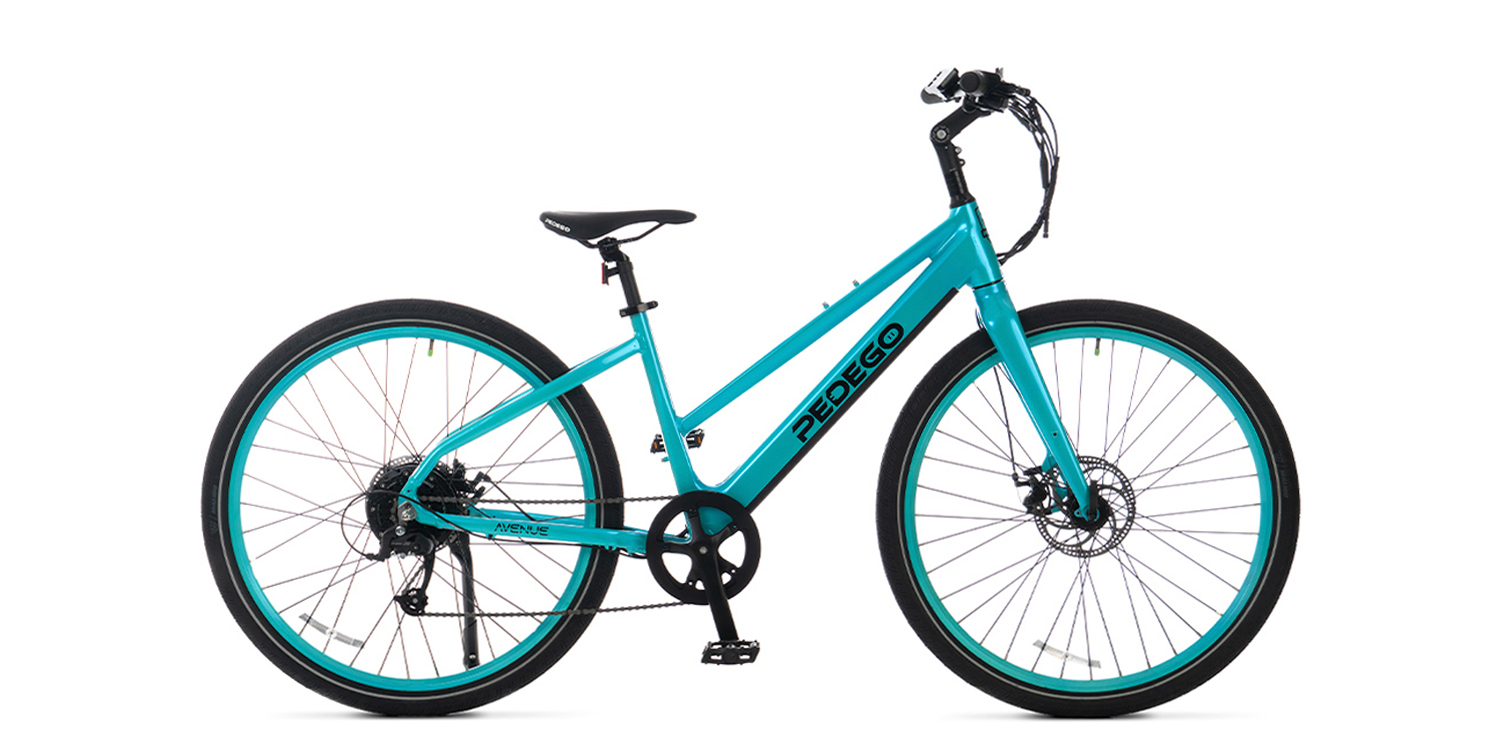
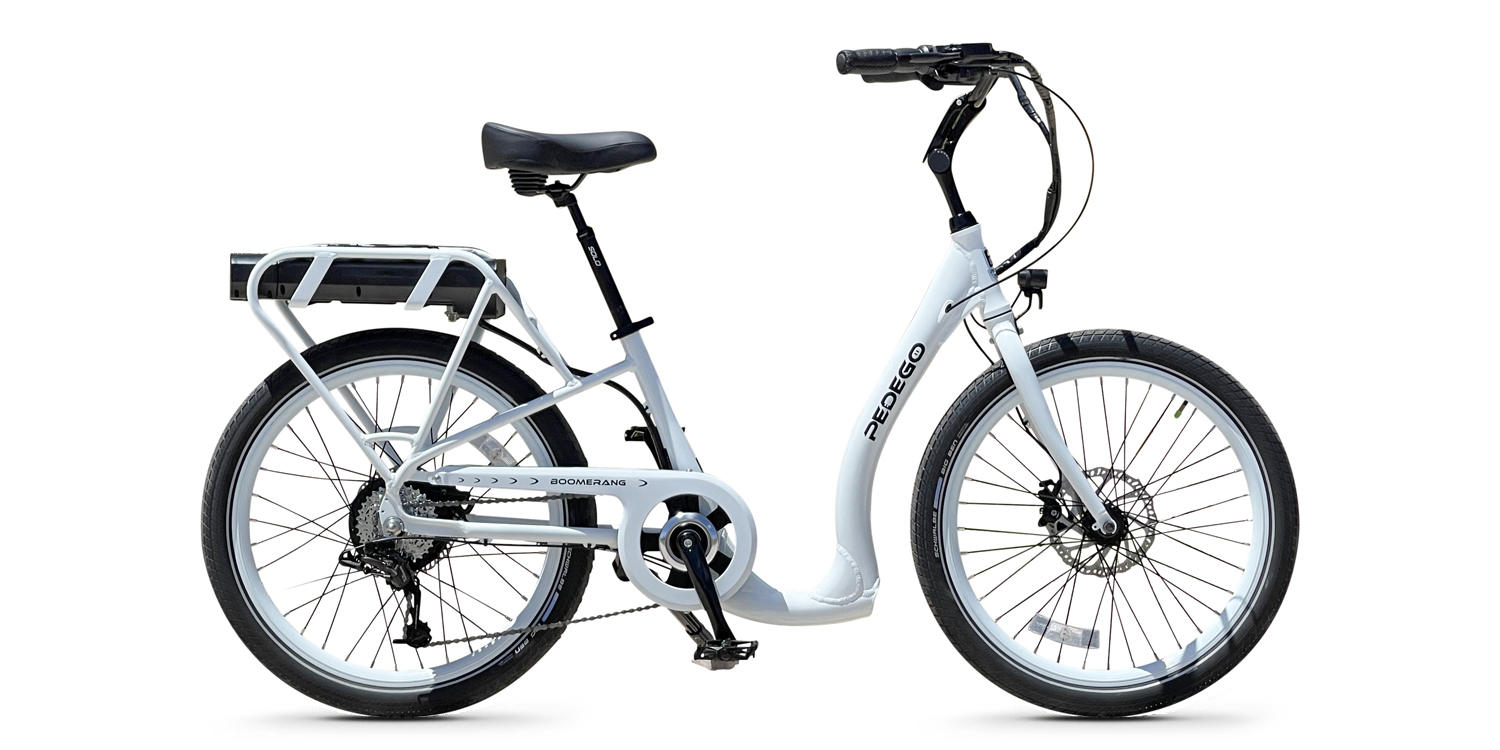
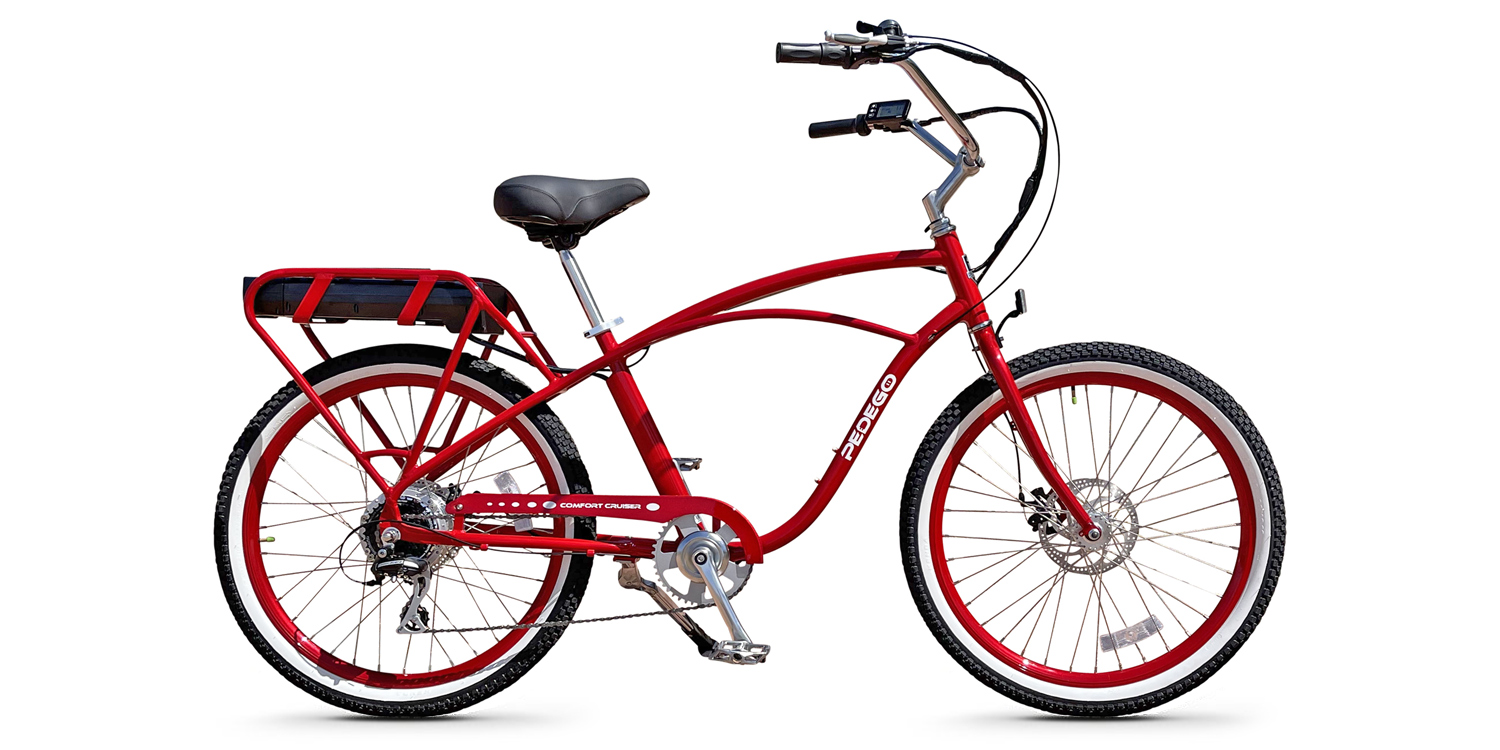
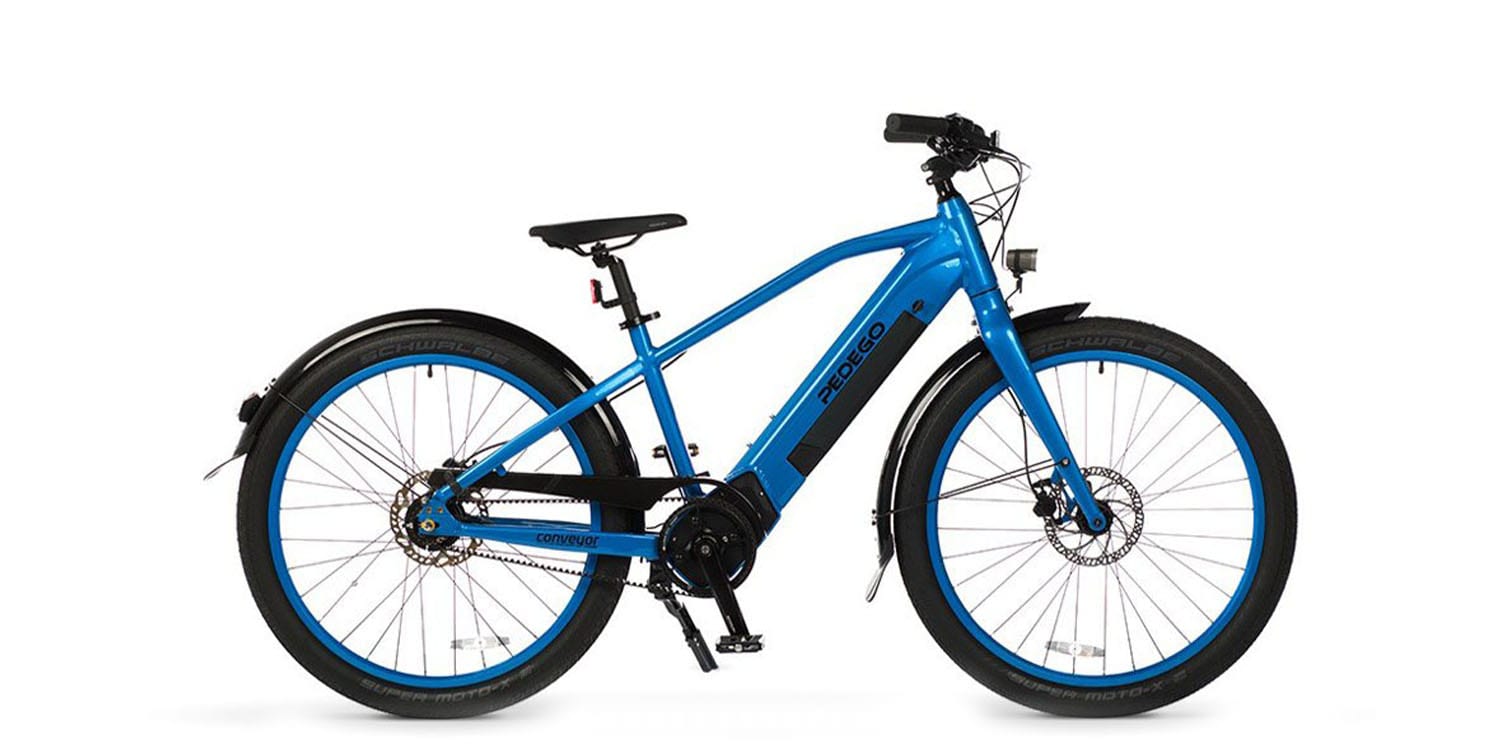
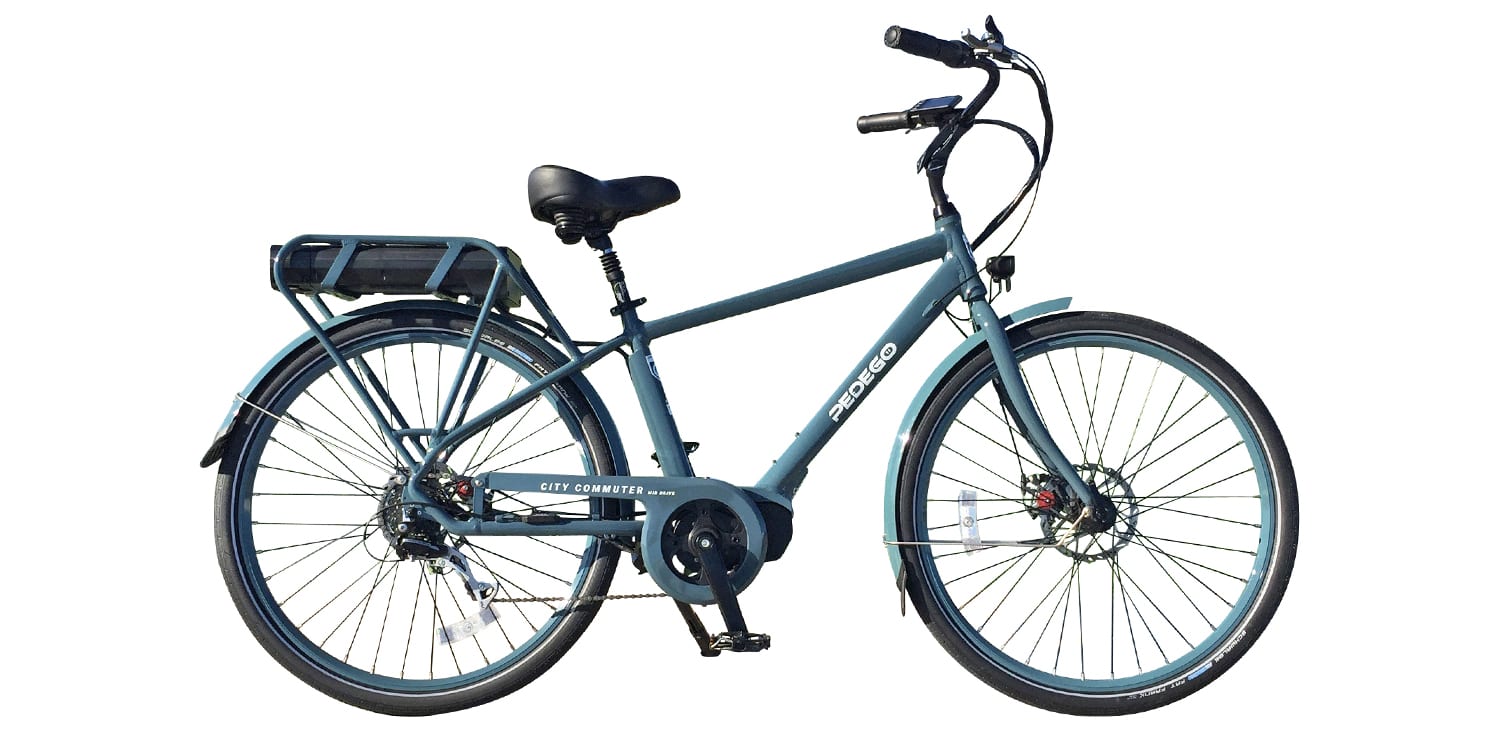

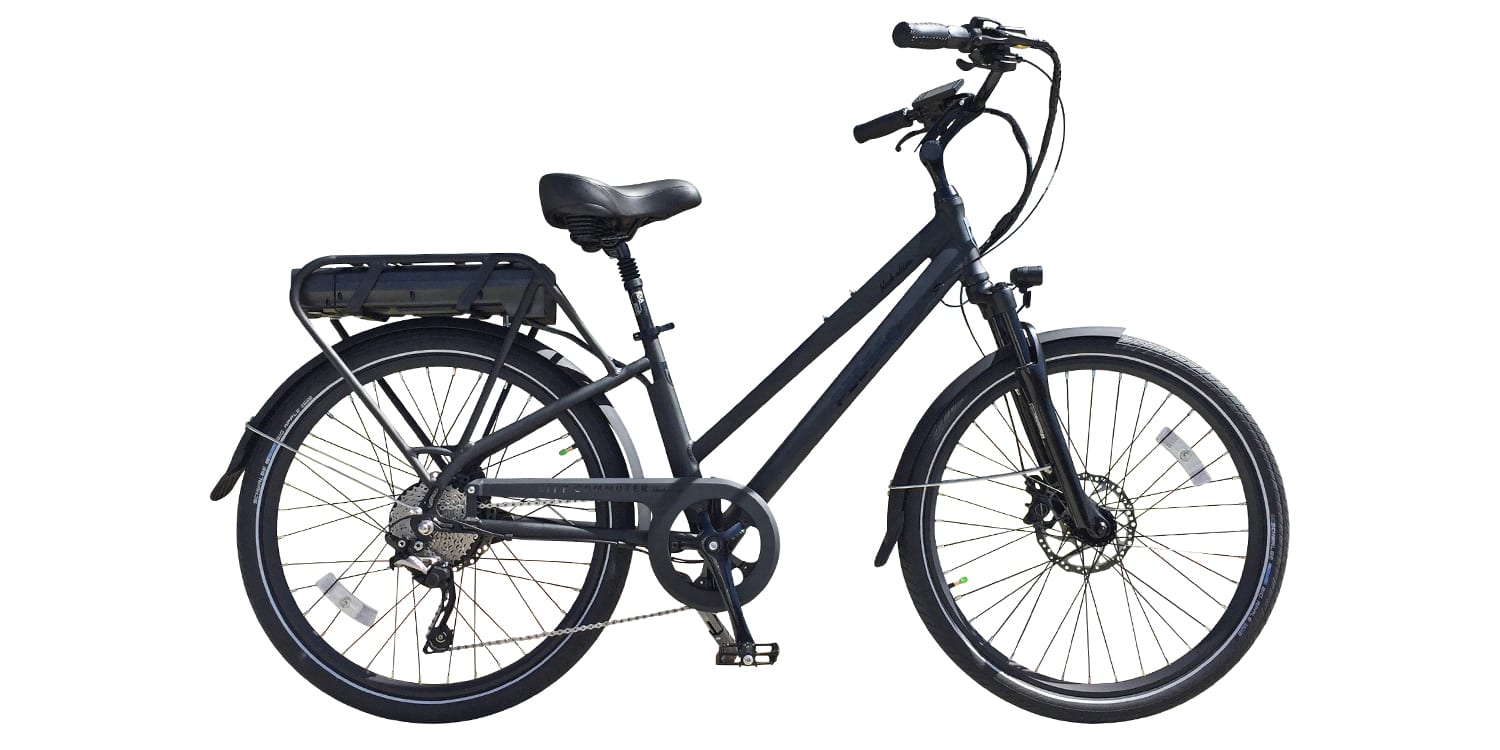
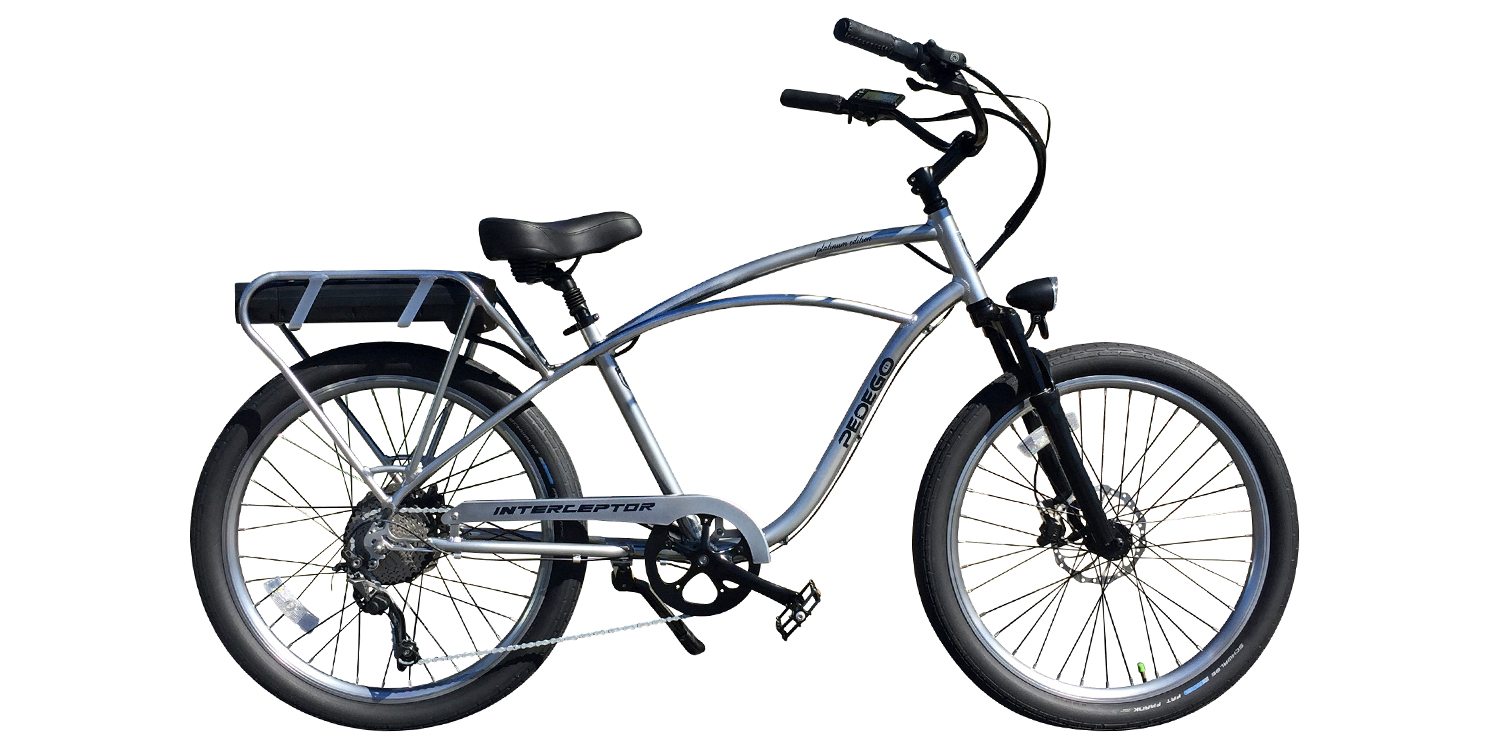
Dave says
WOW! I wish I had something more to say but WOW, does Pedigo really expect people to spend almost $4k for a bike with a rear rack battery? Court may correct me but it seemed he really was searching to find anything substantive for the PRO section. Not impressed.
court says
Hi Dave! It seems like Pedego is continuing to grow, and it’s true that their bikes offer a lot of power and a comfortable ride. I appreciate the different wheel size options, the nicer brakes, deep sleep battery, etc. but there will always be a compromise with rack mounted batteries. The bike still rides pretty well, but there are indeed a lot of different choices now. The biggest plus for this product, in my opinion, is the friendly network of shops that are selling it. Pedego is evolving and adapting their other products (like the Elevate e-mountain bike) and the mid-drive mid-battery make perfect sense there. The city bike is an in-between bike for me right now, the cruiser with rear rack battery makes a lot of sense but city bikes (when actually used for commuting) benefit from frame stiffness, balance, and agility. Thanks for your feedback, excited to see how they evolve the product line in the coming years :)
David says
I’ll qualify this by saying I own a Pedego bike. One of the things about Pedego bikes is that they are all pretty substantially overbuilt. If you are riding the bike hard or are renting bikes you will end up appreciating the ruggedness of their bikes.
Another thing about them is that the dealer and warranty service are somewhere between extremely good and awesome. I have a suspicion that the ruggedness of their bikes is a function of their generous warranty policy — they overbuild the bikes so they don’t eat their profits on warranty repairs.
I do agree that their designs are getting a little tired and they should consider redesigns with the battery either in the bottom tube or just behind the seat tube.
Thanks for the review.
court says
Very fair David, thanks for chiming in! I try to be constructive, but also objective when reviewing each product. I know and appreciate the people who work at Pedego and I also want to honor customers by acknowledging trade-offs. Many Pedego dealers use their products as rentals, in addition to selling new bikes and accessories. This alone is a testament to how durable they are. I feel that they also offer great power and have friendly dealers who aren’t going to belittle new cyclists or make you fight for support when necessary. I’m glad you’ve enjoyed your bike and appreciate your comment :)
Paul says
I like the aesthetic of the rear battery more than some of the big tube batteries that clamp on to the downtube. At least it seems panniers would hide the battery pretty well. Other than a higher COG, are there any drawbacks to a rear rack battery?
court says
Hi Paul! I’m with you, these rear rack batteries are not all that bad… they have worked well for many years and do provide space for adding a trunk bag or panniers. They cost less, they open up the frame, and they can look great. I don’t see many drawbacks besides center of gravity, as you mentioned, and possibly longer cables going up to the control pad, throttle, front light. I guess it’s sort of a wash however, because mid-batteries still have some cabling, just going in both directions vs. rear to front
Paul says
Thank you for your reviews, I enjoy them. Do you know if this bike can be configured to go 28mph? The website for the Dapu M155 motor mentioned speeds between 25-45 kph (~15-28mph). Thanks
court says
Hi Paul! I’m not sure, perhaps there’s a thread about it in the Pedego forums, or you can ask for some feedback in there. I usually just review products as stock in order to honor the intention of the company and help people understand the starting point. Good luck :)
Art says
I have read and/or listened to every word describing the Pedego; with the exception of stating the battery is the most costly item on the bike, nothing is said about the life of the battery or its replacement cost. Also, how does one know if the dealer is including a used battery with a new bike purchase, or even a used bike?
Concerned since I want to buy one.
Court says
Great question, Art. I think most dealers try to keep their battery packs charged up, lightly used, and will work to help you get fixes or replacements if there is a manufacturer warranty issue. The battery pack is consistently one of the most expensive parts on any ebike, from what I’ve seen. Pedego is known for their good dealer support so that puts them above average in my mind :)